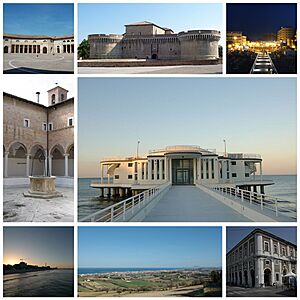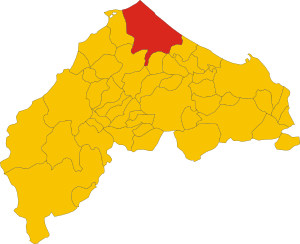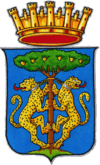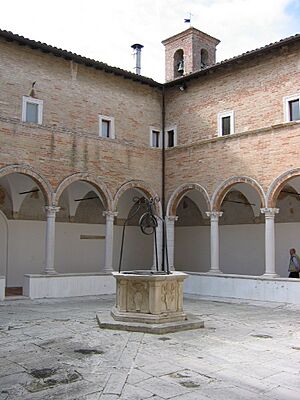Senigallia facts for kids
Quick facts for kids
Senigallia
|
||
|---|---|---|
| Città di Senigallia | ||

Top left: Annonario Square; top centre: Rocca Roveresca Fortress; top right: night view of Piazzale della Libertà waterfront area; middle left: Chiostro delle Grazie; middle right: Rotonda a Mare; bottom left: view of the sunset in Spiaggia Velluto Beach; bottom centre: view of the town from Scapezzano Hill; bottom right: Portici Ercolani
|
||
|
||

Senigallia within the Province of Ancona
|
||
| Country | Italy | |
| Region | Marche | |
| Province | Ancona (AN) | |
| Frazioni | see list | |
| Area | ||
| • Total | 115 km2 (44 sq mi) | |
| Elevation | 5 m (16 ft) | |
| Population
(30 November 2017)
|
||
| • Total | 44,632 | |
| • Density | 388.1/km2 (1,005/sq mi) | |
| Demonym(s) | Senigalliesi | |
| Time zone | UTC+1 (CET) | |
| • Summer (DST) | UTC+2 (CEST) | |
| Postal code |
60019
|
|
| Dialing code | 071 | |
| Patron saint | St. Paulinus | |
| Saint day | May 4 | |
Senigallia is a port town located on the Adriatic coast of Italy. It is part of the province of Ancona in the Marche region. The town is about 30 kilometers (18 miles) north-west of Ancona, the capital city of the province. Senigallia has a small port at the mouth of the River Misa.
Contents
Exploring Senigallia's Past
Senigallia has a very long and interesting history. It was first settled by a group of people called the Senone tribe in the 4th century BC. They were a Gallic (ancient French) tribe who lived along the coast.
From Ancient Rome to the Middle Ages
Around 284 BC, the Romans took over the area. They built a colony there called Sena Gallica. This name helped them control the region, which they called the Ager Gallicus. "Sena" might have come from "Senones," and "Gallica" meant "Gaulish" or "French." This helped tell it apart from another city called Saena (now Siena).
During the Battle of the Metaurus in 207 BC, Senigallia was the furthest point that the Carthaginian general Hasdrubal Barca reached when he invaded Italy. Later, as the Roman Empire declined, Senigallia was attacked by Alaric I. It was then fortified when it became part of the Byzantine Empire.
The town faced more attacks. The Lombards destroyed it in the 8th century, and the Saracens attacked it in the 9th century. In the Middle Ages, Senigallia was one of five important cities in a region called Pentapolis.
The Famous Magdalena Fair
The city grew and became important for trade. Around the 13th century, a big market called the Magdalena Fair started. This fair became very popular. It is said that Sergius, the count of Senigallia, received special relics (items from the past) of Mary Magdalene when he got engaged. These relics helped make the fair famous. Merchants from all over Europe and the Middle East came to trade goods there.
Changes in Power (15th-19th Centuries)
In the 15th century, Senigallia was often fought over during the Guelph and Ghibelline wars. These were conflicts between different groups in Italy. Sigismondo Pandolfo Malatesta helped build up the town's defenses between 1450 and 1455.
Over the years, different powerful families and popes controlled Senigallia. The Della Rovere family held power for a long time. Eventually, in 1624, Senigallia became part of the Papal States, which were lands ruled by the Pope.
Senigallia is also famous as the birthplace of Giovanni Maria Mastai Ferretti, who later became Pope Pius IX. He was born there in 1792. He became pope in 1846 and was the last pope to rule the Papal States before Italy became a united country.
Modern Challenges and Rebuilding
Senigallia faced tough times in the 20th century. During the First World War, the town and its port were heavily shelled by ships from the Austro-Hungarian Navy. The town was also badly damaged by a strong earthquake in 1930. It suffered more damage during the Second World War. Despite these challenges, the city has been rebuilt and continues to thrive.
Senigallia Today: Geography and Neighborhoods
Senigallia is surrounded by several other towns. These include Belvedere Ostrense, Mondolfo, Monte San Vito, Montemarciano, Morro d'Alba, Ostra, and Trecastelli.
Town areas
The municipality of Senigallia includes many smaller areas, often called hamlets or frazioni. These include:
- Bettolelle
- Borgo Bicchia
- Borgo Catena
- Borgo Passera
- Brugnetto
- Cannella
- Castellaro
- Cesanella
- Cesano
- Ciarnin
- Filetto
- Gabriella
- Grottino
- Mandriola
- Marzocca
- Montignano
- Roncitelli
- Sant'Angelo
- San Silvestro
- Scapezzano
- Vallone
What to See in Senigallia
Even though much of Senigallia is modern, you can still find many historical places. Here are some of the main attractions:
- Palazzo Comunale: This is the town hall, built in the 17th century.
- Rocca Roveresca: This is a castle with Gothic origins. It was rebuilt in 1492 and has a square shape with four large round towers.
- The Cathedral: This large church was built after 1787.
- Santa Maria delle Grazie: This is a beautiful church. It also has a museum about mezzadria, which was a type of farming common in the area. The museum shows old farm tools, clothes, and photos. This church once held a famous painting called Madonna di Senigallia by Piero della Francesca.
- Chiesa della Croce: Another important church in the town.
- Rotonda a Mare: This is an Art Nouveau style pier that extends into the sea. It's a popular spot for visitors.
Global Connections
Senigallia has special connections with other cities around the world. These are called twin towns or sister cities. They work together to promote cultural exchange and friendship.
Twin Towns
Senigallia is twinned with:
See also
 In Spanish: Senigallia para niños
In Spanish: Senigallia para niños



